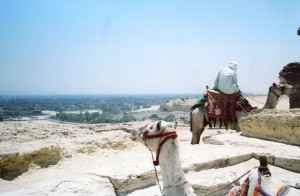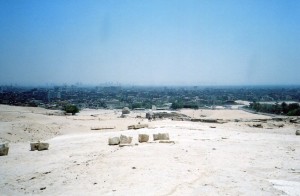Ancient Egypt’s King Khufu had a tough act to follow. His father, Sneferu, founded the 4th Dynasty (2575-2465 BCE), and used more stone mass in his building projects than any other Pharaoh in Egypt’s history–he constructed the Bent Pyramid and the Red Pyramid, both at Dahshur. How could the son top his father?
By perfecting what Sneferu had done. Khufu built on the trial-and-error construction experience in Sneferu’s reign and created a model of perfection that has yet to be surpassed.
Khufu began by selecting Giza as his burial site. Sneferu had chosen Dahshur from scratch. Khufu founded his own estate for the Afterlife. Here are some things that made Giza a perfect place to build one of the greatest monuments in world history:
1. The Giza Plateau is a limestone plate that rises above the Nile–it was more visible from the capital at Memphis, and presided over it like an eternal royal palace.
2. It’s on the west bank of the Nile, like the earlier sites of Dahshur and Saqqara. West was associated with the Afterlife–where the sun sets.
3. The Giza Plateau has a regular surface which is less than a square mile–a perfect frame for a building project that would rule Memphis forever.
4. You can see the pyramids of Giza from Saqqara. I found this to be Giza’s most impressive feature. The pyramids at these sites were visible from each other. Each Pharaoh wasn’t seen as entirely distinct, but as part of a dynastic line. Considering that the pyramids stood out like a row of mountains, people might have thought that all their powers added up as the bastion of order for the state. We moderns are used to seeing each pyramid as a distinct entity. But all together assured a well-run state and universe, and they provoked awe that we can only imagine today.
5. Giza is also within sight of Heliopolis. This is where the cult of the sun god Re was based, and he became a central deity in the 4th Dynasty.
6. Giza is north of Saqqara and Dahshur. Heliopolis is a little north of Giza, and on the east bank of the Nile. Giza thus helped integrate all the sites that pharaohs had built pyramids on with each other, and with Re’s cult.
So Khufu couldn’t have chosen a better place for a building that would stand out like the glorious sun itself–and that would be a model for the permanent geometric forms and ratios that the West would venerate, and also create in ancient Greek temples. What a contrast with the love of abundant forms in much of India’s art. Egyptians and Greeks usually liked to pare things to their clearest and simplest forms.
But the Giza Plateau is only the base. In the next post, we’ll start exploring what Khufu built on it.
Glory to Re!
Glory to Osiris!
Glory to Pharaoh!



Comments on this entry are closed.